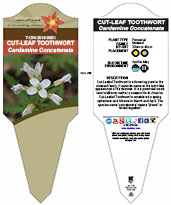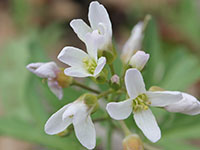![]()
Cut-Leafed Toothwort is a flowering plant in the mustard family. It owes its name to the tooth-like appearance of it's rhizome. It is a perennial woodland wildflower native to eastern North America. Cut-Leafed Toothwort is considered a spring ephemeral and blooms in March and April. The species name 'concatenata' means "joined" or "linked together".
![]()
There is currently no commerical application for cut-leafed toothwort.
![]() Within the rhelm of natural and holistic medince, cut-leaf toothwort leaves were used as a source of vitamin C and a glucoside. Used traditionally in folk medicine, rootstalks were chewed for treating common colds, were used as poultices for treating headaches, and were made into tea for treating hoarseness. The mashed rootstocks have been used as a poultice for treating toothaches. cut-leafed toothwort leaves were also used as a tonic, a stomachic, an expectorant, and an antiscorbutic (scurvy prevention). Toothwort was used various ways to treat heart palpitations and other heart diseases.
Within the rhelm of natural and holistic medince, cut-leaf toothwort leaves were used as a source of vitamin C and a glucoside. Used traditionally in folk medicine, rootstalks were chewed for treating common colds, were used as poultices for treating headaches, and were made into tea for treating hoarseness. The mashed rootstocks have been used as a poultice for treating toothaches. cut-leafed toothwort leaves were also used as a tonic, a stomachic, an expectorant, and an antiscorbutic (scurvy prevention). Toothwort was used various ways to treat heart palpitations and other heart diseases.
Please note that MIROFOSS does not suggest in any way that plants should be used in place of proper medical and psychological care. This information is provided here as a reference only.
![]()
Cut-Leafed Toothwort rootstocks can be used as a substitute for horseradish. Eat rootstalks as a woodland trail nibble or chop them up and use in salads and sandwiches. The rootstocks can also be cooked and added to soups, stews, or meats. Peppery tasting leaves and stems are also edible. The leaves of cut-leafed toothwort can also be used as a potherb.
Please note that MIROFOSS can not take any responsibility for any adverse effects from the consumption of plant species which are found in the wild. This information is provided here as a reference only.
![]()
Cut-Leaf Toothwort grows in rich woods, thickets, wooded bottomlands, ravines, meadows, rocky banks and bluffs, and limestone outcrops. Cut-Leafed Toothwort is suitable to grow in partial or full sun.
| Soil Conditions | |
| Soil Moisture | |
| Sunlight | |
| Notes: |
![]()
Cut-Leafed Toothwort can grow 20cm to 40cm high rising from a segmented rhizome. The leaves are on long petioles, deeply and pedately dissected into five segments with large serrate teeth on the margins. The white to pinkish flowers are held above the foliage in a spike. Fruit is an elongated pod which can be up to 4 cm long.
![]()
| Plant Height | 20cm to 40cm |  |
| Habitat | Woodlands | |
| Leaves | Pedate with five seagments | |
| Leaf Margin | Serrate (large teeth pointing forward) | |
| Leaf Venation | Pinnate | |
| Stems | Smooth stems | |
| Flowering Season | April to May | |
| Flower Type | Rounded Clusters of flowers | |
| Flower Colour | White, sometimes pink | |
| Pollination | Wind, Insect | |
| Flower Gender | hermaphrodite (have both male and female organs) | |
| Fruit | Narrow, upward angled pod | |
| USDA Zone | 5A (-26.2°C to -28.8°C) cold weather limit |
![]()
No known health risks have been associated with cut-leaf toothwort. However ingestion of naturally occurring plants without proper identification is not recommended.
![]()
 |
-Click here- or on the thumbnail image to see an artist rendering, from The United States Department of Agriculture, of cut-leaf toothwort. (This image will open in a new browser tab) |
![]()
Cut-Leaf Toothwort can be referenced in certain current and historical texts under the following seven names:
Cut-Leaf Toothwort can be translated into the following select languages:
| Arabic | كوت-ليف، توثورت | Bulgarian | нарязани листа от зъби | Chinese (Sim) | 切叶银花 |
| Croatian | izrezati list | Czech | řezaný listový zub | Danish | skærebladet tandvort |
| Dutch | tandwortel met open blad | Esperanto | kruta folio | Estonian | lõigatud lehe hambakivi |
| Finnish | leikattu lehti-hammaslääkäri | French | denture à feuilles coupées | German | Schnitt-Blatt-Zahnkraut |
| Greek | οδοντόβουρτσα | Hebrew | גוזל שיניים | Hungarian | vágott levél fogoly |
| Italian | Japanese | 切葉葉 | Korean | 컷 리프 치약 | |
| Punjabi | ਕਟ-ਪੱਤੀ ਟੋਸਵੌਰਟ | Lithuanian | pjovimo lapų dantis | Norwegian | kuttebladetann |
| Persian | آطوقه برش برگ | Polish | wycięty ząb | Portuguese | dente de dente de folha cortada |
| Romanian | Russian | вырезанный листовой зубец | Slovak | rezaný listový zub | |
| Spanish | diente de hoja cortada | Swedish | snittbladig tandvård | Tagalog | |
| Turkish | kesilmiş yaprak diş | Ukrainian | різаний листовий зуб | Vietnamese |

![]()
 |
The MIROFOSS database offers free printable garden tags for personal and non-profit use. These tags can be used to properly identify plant samples in a garden. Click on the tags shown on the the screen or -click here- to download a full size jpeg image for a cut-leaf toothwort identification tag; which can be printed on paper or used with a plastic laser printer. |
 |
What's this? What can I do with it? |
![]()
| Biology | Dickinson, R; Royer, F (2014) Plants of Southern Ontario. ISBN 978-1-55105-906-8 |
| Biology | Kartesz, J.T. 1994. A synonymized checklist of the vascular flora of the United States, Canada, and Greenland. 2nd edition. 2 vols. Timber Press, Portland, OR. |
| Biology | Dickinson, T.; Metsger, D.; Bull, J.; & Dickinson, R. (2004) ROM Field Guide to Wildflowers of Ontario. Toronto:Royal Ontario Museum, |
| Image Rendering | USDA-NRCS PLANTS Database / USDA NRCS. Wetland flora: Field office illustrated guide to plant species. USDA Natural Resources Conservation Service. |
| Environment | National Audubon Society. Field Guide To Wildflowers (Eastern Region): Alfred A. Knopf. ISBN 0-375-40232-2 |
| Physical Identification | National Audubon Society. Field Guide To Wildflowers (Eastern Region): Alfred A. Knopf. ISBN 0-375-40232-2 |
| January 15, 2018 | The last time this page was updated |
| ©2025 MIROFOSS™ Foundation | |
 |
|











